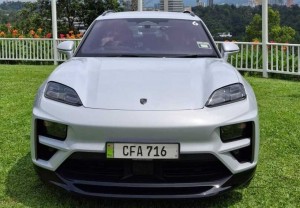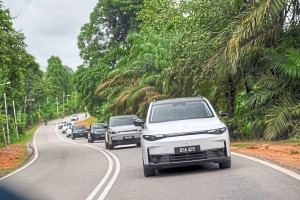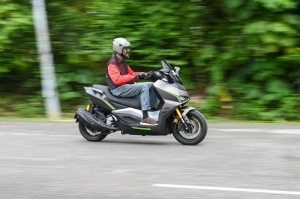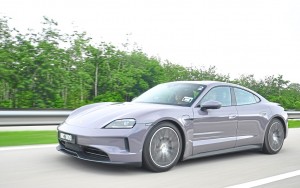NEW YORK: Hybrids were supposed to be a way station on the road to electric cars.
Honda Motor Co. and Toyota Motor Corp. started pushing them in the late 1990s, using their part electric, part internal combustion powertrains to meet emissions mandates and lower CO2 ratings across their global fleets.
They wagered that hybrids were an easier sell to consumers than the full-on electric vehicles a few early adopters and tech geeks were driving.
Soon everyone would transition and leave gasoline behind for good, the thinking went.
Even luxury brands joined in, with Lexus introducing the RX400h in 2004. By 2013, high-powered halo hybrids such as the BMW i8, Ferrari LaFerrari, McLaren P1 and Porsche 918 had appeared.
But the leap to a world of all-electric driving hasn’t occurred.
Concerns about high sticker prices and limited charging infrastructure have slowed EV sales, disappointing projections so deeply that it’s prompting factory closures for Volkswagen AG, generating low order rates at Mercedes-Benz Group AG and returning such slim profits that shares at Porsche AG have slumped by more than a third in the past year.

"EV sales growth today is far less dynamic than it was in 2022,” Mark Schirmer, the director of industry insights for Cox automotive, wrote in an email on July 17.
These days, the hybrid powertrains that were once considered merely a bridge to an electric-only Nirvana are turning out to have a more lasting appeal than expected, with their triple threat of decreased emissions, increased power and do-gooder image.
"All the big (automakers) have already changed their plans to go full electric,” says Stephan Winkelmann, the CEO of Lamborghini, which announced its US$608,358 Revuelto hybrid last year.
Two more Lamborghini hybrids, including the plug-in version of the Urus SUV, will make their debut in August. "Nobody’s judging and doubting hybridiSation.”
Mercedes-Benz will make hybrids like its Mercedes-AMG S63 E Performance "well into the 2030s,” chief executive officer Ola Källenius told Bloomberg in May, a significant reversal of a prior plan to sell only EVs by then.
BMW offers five plug-in hybrids, with two more in the M5 family on the way.
Hybrids will continue to play a "meaningful” role at BMW, a spokesperson confirmed.

Defender announced its 626-horsepower Defender OCTA hybrid (US$152,000) on July 2, fulfilling what the company described as "surprising” demand for more hybrids.
Porsche will deliver it first 911 hybrid, the 2025 Porsche 911 Carrera GTS (US$165,000) later this year.
It’s the "next step into our electrification strategy while still offering our customers the choice to stay with an internal combustion engine if they want to,” says Timo Resch, president and CEO of Porsche Cars North America.
Hybrid sales across all marques nationwide are up 152% in 2024, with plug-in hybrid sales alone up 59%, according to data provided by Cox automotive.
Luxury hybrids in particular show strong growth: As of May, they account for 7.5% of all luxury vehicle sales this year, a 2.1-percentage-point increase from the same period last year, according to J.D. Power. That’s an increase of 20,500 units, up 39%.
Simply put, says Anthony Salerno, the vice president of J.D. Power, "consumer interest in hybrids is rising.”
The way forward in luxury
Ferdinand Porsche himself built the world’s first hybrid in 1899, making more than 300 of them until Henry Ford presented his gas-only Model T as a more affordable and more powerful option.
Combustion engines soon dominated the market, but hybrids slowly reemerged with General Motors Co.’s experimental EV1 hybrid in the 1990s, Toyota’s Prius that debuted in Japan in 1997, and the Honda Insight, which in 1999 became the first mass-produced hybrid released in the US.
Some, like the mild hybrid Insight, were valued for their no-fuss charger-less practicality and almost imperceptible use of electric motors that improved acceleration.
Plug-in hybrids like the Prius Prime offer electric-only driving, if only for a limited range.
It took another five years after the Insight before the first luxury hybrid debuted, the Lexus RX400h.
The plug-in SUV won fans for its fuel efficiency of 9.1 l/100km compared to the 14.8 l/100km of the base RX model and an electric-only driving range of nearly 64km.
Starting around US$50,000, it cost more than the US$37,000 non-hybrid RX but found a niche market among wealthier buyers.
"Initial demand was strong, helped by Lexus’ reputation for quality and reliability,” Salerno says.
The move to higher-end brands took longer. Executives agonised over hybrids’ costs and reliability, weighing emissions targets and lack of consumer education against volume, pricing and profitability.
The early hybrid supercars that appeared around 2013 helped legitimise the technology within the segment. They proved engines pushed by electricity could be fast and powerful enough to offset their inevitable weight gain, Salerno says.
"These (halo) vehicles demonstrated that eco-friendly can coexist with luxury and high performance, maintaining the visceral driving experience that is often lost in fully electric vehicles,” he says, comparing the merits of electricity to cooking beef.
"Microwaving burgers is quick, but grilling brings out the flavour.”
The rise of hybrids in this elite enclave has been especially pronounced-and polarising.
Several prominent high-caliber, low-volume brands like Rolls-Royce and Pininfarina have skipped hybrid technology altogether. Executives eschewed it as a crutch rather than permanent solution.
"We will not do hybrids or whatever,” Rolls-Royce’s then-CEO Torsten Müller-Otvös declared in 2018.
"Our proposition is full electric.”
Former Lamborghini engineering guru Maurizio Reggiani says a hybrid powertrain was never an option for his forthcoming V12 Lamborghini Diablo, because it would diminish the thrill of the drive in the €1.35-million car.
"Hybrid is a solution in order to fulfill the necessity of emissions,” he says. "But if you want to have fun, you need to be lighter.”
Others have done just the opposite.
Bentley debuted its first hybrid Continental GT sports car July 11 at the Goodwood Festival of Speed and announced June 18 that it will hybridise the Flying Spur, making it the most powerful and most efficient four-door car in Bentley’s 105-year history.
Bugatti will show its first hybrid, the 1,800-horsepower Tourbillon, on Aug 16 during Monterey Car Week.
Ferrari NV debuted the plug-in Ferrari SF90 Stradale hybrid in 2019, then the 296 GTB and 296 GTS hybrids in 2021 and 2022, respectively.
They’re part of the company’s enormous investment in the technology; a spokesperson declined to comment on how much is being spent but confirmed the budget includes building a €200-million "e-building” factory.
To say the hybrid program at Ferrari is going well would be an understatement. Last year the company reported more than 40%, and in some quarters more than 50%, of the vehicles it sold were hybrids.
On June 26, it announced it will offer an extended warranty service for its next generation of hybrid and electric supercars.
Meanwhile, Lamborghini’s order books are full until 2027 for the Revuelto, its third hybrid after the Sian of 2020 and Countach LPI 800-4 of 2022.
"We are in the lucky position that we’re starting with hybridisation now-we have almost a decade in front of us where we can live with hybridisation,” Winkelmann says.
"If you would’ve asked super sports car companies about hybridisation five, six years ago, the statement would've been different.”
Going fast beats going green
Engineers at the luxury brands leaning into hybrids insist the technology is as much about getting more performance out of existing combustion engines as it is about going green.
At Bugatti, for instance, the Tourbillion’s V16-and-electric-motor system achieves 300hp more than its Chiron predecessor.
Porsche’s hybrid GTS ended up with almost 60 more horsepower and shaved off nearly half a second in the 60 mph sprint compared with the Carrera GTS predecessor, even though they both use a flat-six-cylinder "boxer” internal combustion engine.
"We wanted to increase the performance of the car, but stay with the package of the car as much as possible,” says Frank Moser, vice president for corporate quality at Porsche AG.
Maintaining the design and driving quality of the 911 is "not compatible” with the additional weight, balance and space requirements of an all-electric system, he says.
But a hybrid powertrain taps the explosive raw power of combustion and the instantaneous speedy zap of electricity. It’s the best of both worlds.
As for the efficiency and emissions benefits of that new Carrera GTS compared with the previous non-hybrid version? Moser puts it this way: "They’re not worse.”












